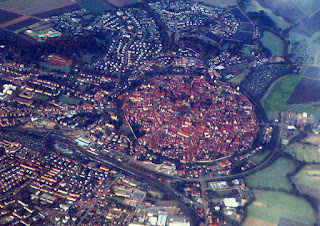As a kind of farewell present, I said I'd run a game of their choice, and they opted for 5th Edition Dungeons & Dragons, which until now I'd never run. I've played D&D before, of course - red box, DMG with the Efrit on the cover, 3.5, yadda yadda. But I stopped at 3.5. Now I've been talked into giving 5th a go, I must admit, I'm pleasantly surprised. It's by far the easiest of the systems to run, and it's not so chart-heavy simulationist as to frighten off the new player.
I thought I'd play with the concept a little bit, and design a fantasy town. Keepers running 13th Age games, take note: while I won't go heavily into 13th Age stuff, there's no reason why you couldn't pillage this for use in your game.
Begin at the beginning: why design a town? Mainly because the players need a base of operations, somewhere they can return to for supplies, healing, and emotional support, after the dragons have ruthlessly mocked their combat skills, dubious parentage, and other weak points. Of course, that base could be anything - wizard's tower, hobbit village, elven shrine - but by making it a town, you open up a variety of different plot threads. Ultimately there's only so much mystery to be had in a tower. If you design a town, there's a lot you can leave blank, to be filled in later. Plus, there's more chances for other fantasy races to get involved. Hobbit villages are all very well, but unless you're planning on putting a half-orc ghetto on the outskirts of Hobbiton - and Bilbo Baggins strikes me as the ultimate NIMBY - there's only so much diversity to be had.
Let's start with the very basics: what kind of town, and what kind of setting? Is it a trading outpost, a manufacturing town, a great port? Is this broadly Northern European, Mediterranean, Pacific island waystation, ancient necropolis on the outskirts of a vast wasteland?
I like the idea of the town being able to supply something nowhere else can. Its unique status means it'll be fought over by all the powers, but it also means everyone will want to go there. Merchants will send their caravans, nobles and leaders their emissaries, and everyone else will want to go just to say they've been.
That brings me to Nordlingen. If you've ever spent five minutes on the internet, you've probably seen an article or photograph, as it's famous in an Atlas Obscura kind of way.
About 15 million years ago a meteorite smacked into what is now Bavaria, creating a massive bowl-shaped crater, about 14 kilometers wide, between 100 to 150 meters deep. Over time humans arrived, and started building in that crater. They didn't know it was caused by a meteorite; they thought it was a volcano. Be that as it may, they started quarrying the remains of the meteorite and using the diamond-encrusted stone as building material. The diamond remnants are breathtakingly small - about 0.2 mm across - but there are uncounted hundreds of thousands of them embedded in the bricks and stones of Nordlingen.
So let's poach that, and posit: millennia ago, a meteorite smashed into the earth, bringing with it large quantities of precious minerals. Most of it was smashed into pieces so small that they can't be seen except with the most delicate of instruments, but there are still portions large enough to be quarried, shaped, and polished to a fine sheen. These gems, found nowhere else on earth, are prized highly by magical scholars, for their mystic properties. Physically, I picture them as similar to rubies, but with an internal, captivating flicker.
Sorcerers and Warlocks, particularly Tieflings, are drawn to this place like a moth to a flame, and the Tiefling community here is larger and more politically powerful than in any other place in the realm. A great river runs nearby, and merchants from across the realms send their caravans, offering up the wealth of kings in exchange for the magical gems of this proud city.
As a government, I see this as a town where the craftsmen's guilds have taken over, big time. There was a noble leader at one point, and there probably still is a kind of rump nobility - someone to wear the pretty hat and wave at ceremonies. But the guilds wear the pants in this metaphorical marriage. They pay for defense, they negotiate with other powers, they write and enforce the laws. If they want something done, it gets done, or there'll be trouble.
With this much money at stake, there's bound to be a Thieves' Guild. They'd have to tread softly with all these Craftsman's Guild enforcers wandering around ostentatiously sharpening their weapons, but that's never stopped a greedy man before. Besides, merchants will want a way around all those tariffs the Craftsmen's Guild imposes, and getting around tariffs is what a good Thieves' Guild is all about.
The only thing I haven't discussed so far is cultural location. What kind of place is this? Well, I've mentioned rubies, and that always makes me think of tropical locales. Myanmar, in Southeast Asia, has long had a reputation as a source of rubies. So we're talking cloudy, rainy, with hot, humid summers, and a parched dry season in winter. There are mountains to the north, but I don't see the town in a mountainous locale. Tropical forest covers most of the countryside, and the great river sweeps down to the delta and far away, to the wide, trackless ocean.
So I give you Akkat: Mother of the Sunrise, jewel of the great Chinda River, where the Asteria, or Star, gems come from.
Next post shall be a deeper dive into Akkat. What makes it tick, and what kind of adventure can be found there?

No comments:
Post a Comment